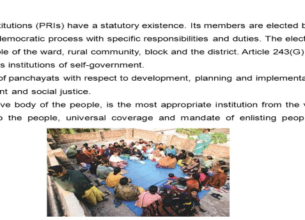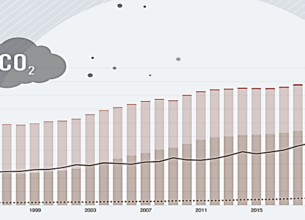PARIS AGREEMENT TARGETS
25, Aug 2019

Prelims level : Environment- Climate Change
Mains level : GS-III- Conservation, environmental pollution and degradation, environmental impact assessment. GS-II- Bilateral, regional and global groupings and agreements involving India and/or affecting India’s interests.
- Context: In their recent joint declaration, India and France have committed to making long-term plans to contain emissions.
Background:
- During Prime Minister of India’s visit to Paris last week, a substantial part — nine out of 34 paragraphs — of the Joint Statement by India And France was dedicated to the related issues of:
- Climate change,
- Biodiversity,
- Renewable Energy, and
- Ocean resources.
- It talked about the two countries’ commitment to enhanced climate actions, their support for new low-carbon technologies, and their ongoing efforts to accelerate development and deployment of renewable energy.
- It mentioned the need for sustainable use of marine resources, acknowledging the link between environment and security, and promised to work towards “ocean governance”.
What is Ocean Governance?
Ocean governance is the integrated conduct of the policy, actions and affairs regarding the world’s oceans to protect ocean environment, sustainable use of coastal and marine resources as well as to conserve of its biodiversity.
- The two sides also promised to develop, by next year, strategies for containing their greenhouse gases in the long-term period, possibly for the next 30 or 50 years.
- From India’s point of view at least, a longer-term low-carbon pathway would be a new development.
Countries & Climate Targets:
- Under the 2015 Paris Agreement on climate change, which will come into force next year, every signatory country is supposed to declare and implement a climate action plan, called Nationally Determined Commitments (NDCs).
What are Nationally Determined Commitments (NDCs).
Nationally determined contributions (NDCs) are at the heart of the Paris Agreement and the achievement of these long-term goals. NDCs embody efforts by each country to reduce national emissions and adapt to the impacts of climate change.
The Paris Agreement (Article 4, paragraph 2) requires each Party to prepare, communicate and maintain successive nationally determined contributions (NDCs) that it intends to achieve.
Parties shall pursue domestic mitigation measures, with the aim of achieving the objectives of such contributions.
- Targets:
- Until now, countries have mostly announced their targets for 2025 or 2030. India’s declared targets, for example, are for 2030.
- It has said it would bring down its emission intensity, or emission per unit of GDP, by 33 to 35 per cent by 2030 compared to 2005 levels.
- It has further promised to ensure that at least 40 per cent of its electricity in 2030 would be generated from non-fossil sources, and to create an additional carbon sink of 2.5 to 3 billion tonnes through forests.
- Each of these actions, and many more for which specific targets have not been declared, would contribute in reducing India’s greenhouse gas emissions.
- All other signatories to the Paris Agreement have declared similar action plans. NDCs have to be updated every five years.
- The first set of NDCs were declared in 2015 ahead of the climate change conference in Paris. Countries will have to update these next year.
- The Paris Agreement asks all signatories to ensure that successive NDCs represent a progression from their current targets.
- Countries have also been asked to evolve a common time-frame for their action plans. Successive NDCs, therefore, would all be five-year or ten-year action plans.
Longer-Term Vision:
- It has long been argued that countries need to finalise and commit to longer-term climate targets, over 30-year or 50-year time horizons.
- This will not just help in bringing more predictability into climate actions but also make it easy to monitor whether the world was progressing adequately to avoid the catastrophic impacts of climate change.
- It is argued that short-term targets can lack the urgency of the task, and can delay ambitious action, so that a couple of decades later, the climb could become so steep that it would be impossible to scale.
- In this context, there is a growing clamour to put pressure on the big emitters – China, the United States, European Union, India, Russia, Brazil, Australia – to come up with long-term action plans, in particular to aim for net-zero emissions in the year 2050.
- The noise is strongest in Europe, since it is the biggest combined emitter from the developed country group after the United States, which has announced a withdrawal from the Paris Agreement under the Trump administration.
- Europe:
- As part of its NDCs, the European Union of 27 countries has set a combined target of 40 per cent reduction in its greenhouse gas emissions by 2030 from the 1990 levels.
- Last year, however, it also came up with a long-term vision, saying Europe would aim to become climate-neutral, or attain the goal of net-zero emissions, by 2050.
- UK:
- Two months ago, the United Kingdom became the first major economy to legislate a law to make itself climate-neutral by 2050. It had been previously aiming to achieve an 80 per cent reduction from the 1990 levels.
- As climate-induced extreme weather events bring in more and more disasters across the world, the demand for longer-term commitments on climate action has been increasing.
- Two recent reports by the Intergovernmental Panel on Climate Change (IPCC) – on the feasibility of containing global rise in temperatures to within 1.5°C from pre-industrial times, and another on state of climate-induced land degradation – have also stressed the need for more urgent and ambitious climate action in longer term.
Long-Term Action in Indian Context:
- India, being a developing country, is treated differently from developed country parties like the US, European Union or Australia in the Paris Agreement.
- It is not obligated to take as ambitious targets as the developed world.
- But India also happens to be the third biggest emitter of greenhouse gases, after China and the United States, if the European Union is not counted as one entity.
- As such, there have been demands from India, as well as other major developing economies such as Brazil and South Africa, to also come up with longer-term commitments.
- In fact, there was a move from France to encourage India to make a commitment like this in the joint statement itself, but New Delhi resisted the pressure.
- India’s Stand:
- India says, being a developing country, it was already doing much more than many developed countries, and committing to anything more than that was likely to hamper its development imperatives.
- It has also said that it was on course for achieving all its targets under its NDC well in time, and may even over-achieve them.
- But New Delhi is also conscious of the fact that the developed countries are far from delivering on their climate promises, especially on their obligation to provide money and technology to help developing and poor countries in fighting climate change.
- India had ratified the Paris agreement on climate change in 2016 to become the 62nd nation to join the deal.
What is Paris Agreement:
- The Paris Agreement builds upon the Convention and for the first time brings all nations into a common cause to undertake ambitious efforts to combat climate change and adapt to its effects, with enhanced support to assist developing countries to do so. As such, it charts a new course in the global climate effort.
- The Paris Agreement central aim is to strengthen the global response to the threat of climate change by keeping a global temperature rise this century well below 2 degrees Celsius above pre-industrial levels and to pursue efforts to limit the temperature increase even further to 1.5 degrees Celsius.
- Additionally, the agreement aims to strengthen the ability of countries to deal with the impacts of climate change.
- To reach these ambitious goals, appropriate financial flows, a new technology framework and an enhanced capacity building framework will be put in place, thus supporting action by developing countries and the most vulnerable countries, in line with their own national objectives.
- The Agreement also provides for enhanced transparency of action and support through a more robust transparency framework.








